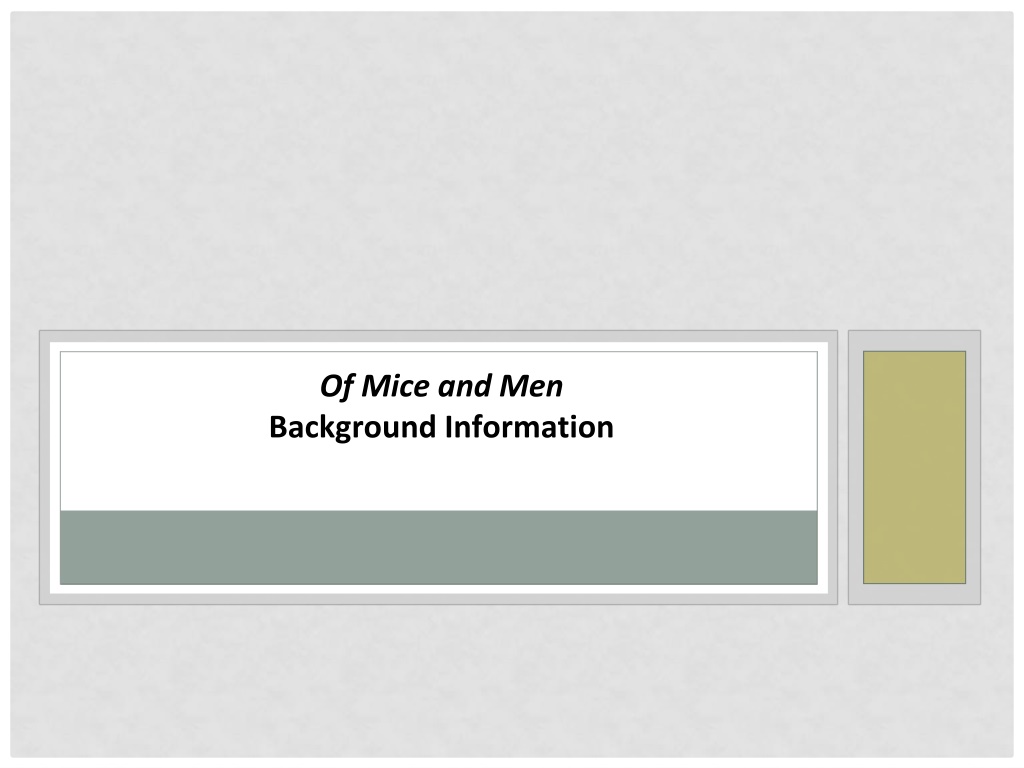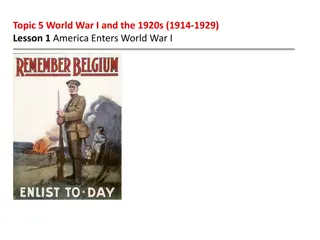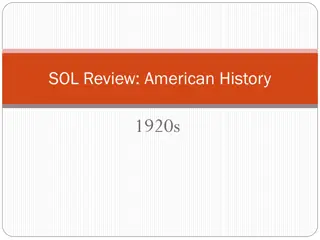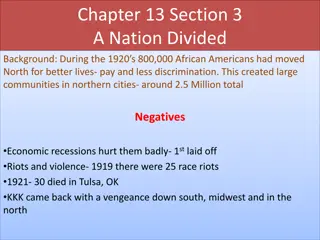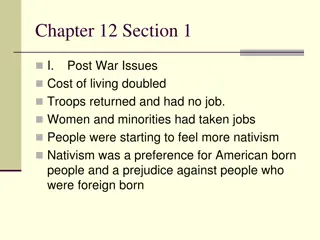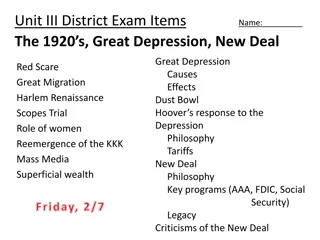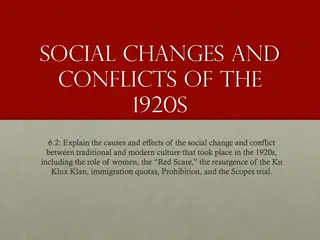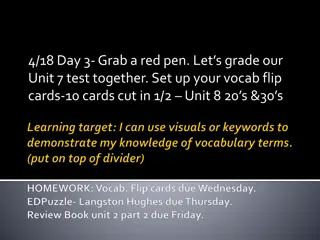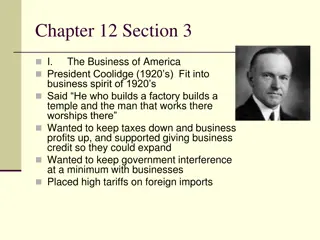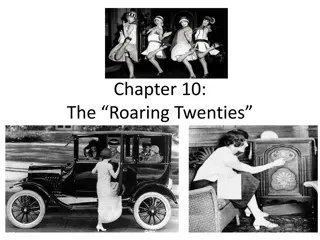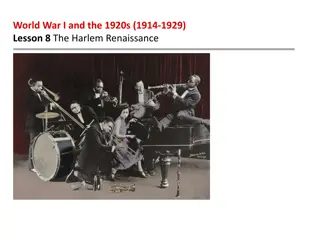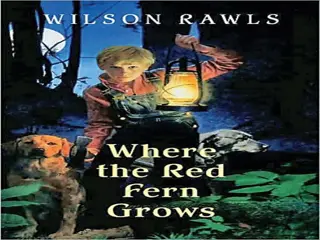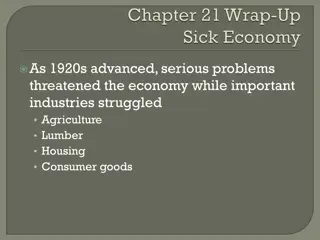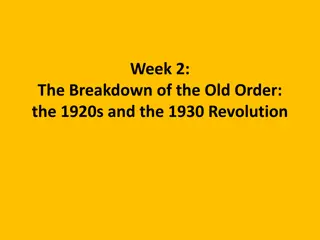Exploring 1920s America Through Literature and History
Delve into the social, historical, and cultural context of the 1920s America through works like "Of Mice and Men" and "The Great Gatsby". Experience the vibrant Roaring Twenties, the Dust Bowl, and the Great Depression that shaped a generation. Analyze music, literature, and film to understand the era's impact on society and art.
Download Presentation

Please find below an Image/Link to download the presentation.
The content on the website is provided AS IS for your information and personal use only. It may not be sold, licensed, or shared on other websites without obtaining consent from the author. Download presentation by click this link. If you encounter any issues during the download, it is possible that the publisher has removed the file from their server.
E N D
Presentation Transcript
Of Mice and Men Background Information
CONTEXT: AN INTRODUCTION TO 1920S AMERICA SOCIAL, HISTORICAL AND CULTURAL SOCIAL, HISTORICAL AND CULTURAL CONTEXT CONTEXT. . Play and listen to the following: THE ORIGINAL MEMPHIS FIVE #1 How did it make you feel? #2 Compare and Contrast to today s music.
The Roaring Twenties READ THE EXTRACT FROM THE GREAT GATSBY BY F. SCOTT FITZGERALD. IT WAS FIRST PUBLISHED IN 1925, TWELVE YEARS BEFORE STEINBECK S OF MICE AND MEN. THE NOVEL IS SET IN NEW YORK DURING THE ROARING TWENTIES. #: 3 What were the Roaring Twenties like? The bar is in full swing, and floating rounds of cocktails permeate the garden outside, until the air is alive with chatter and laughter, and casual innuendo and introductions forgotten on the spot, and enthusiastic meetings between women who never knew each other's names. The lights grow brighter as the earth lurches away from the sun, and now the orchestra is playing yellow cocktail music, and the opera of voices pitches a key lighter. Laughter is easier minute by minute, spilled with prodigality, tipped out at a cheerful word. The groups change more swiftly, swell with new arrivals, dissolve and form in the same breath; already there are wanderers, confident girls who weave here and there among the stouter and more stable, become for a sharp, joyous moment the centre of a group, and then, excited with triumph, glide on through the sea-change of faces and voices with colour under the constantly changing light. Suddenly one of these gypsies, in trembling opal, seizes a cocktail out of the air, dumps it down for courage and, moving her hands like Frisco, dances out alone on the canvas platform. A momentary hush; the orchestra leader varies his rhythm obligingly for her, and there is a burst of chatter as the erroneous news goes around that she is Gilda Gray's understudy from the Follies. The party has begun. Life in the
WATCH THIS SHORT CLIP https://www.youtube.com/watch?v=gplaqa2yRgg&feature=related The Dust Bowl and the Great Depression 4 4. . Describe Describe the descriptive descriptive adjectives the faces faces of of the adjectives. . the people people in in the the film film using using three three 5 5. . Why Why were were so so many many of of them them queuing queuing (standing (standing in in line)? line)? 6 6. . What What kind kind of of work work were were the the men men looking looking for? for? 7 7. . Describe Describe their adjectives adjectives. . their lives lives (in (in your your opinion) opinion) in in three three descriptive descriptive
8 8. . What words does this newspaper use to show What words does this newspaper use to show how bad the situation was? how bad the situation was?
THE GREAT DEPRESSION On Black Tuesday, October 29, 1929, the stock market crashed, triggering the Great Depression, the worst economic collapse in the history of the modern industrial world. It spread from the United States to the rest of the world, lasting from the end of 1929 until the early 1940s. With banks failing and businesses closing, more than 15 million Americans (one- quarter of the workforce) became unemployed.
THE FARMERS To make matters worse America was hit by a series of droughts and many farms could no longer operate. 9 9. . Describe the picture using imagery: sight, sound, Describe the picture using imagery: sight, sound, and feel and feel. 10. 10. How would the droughts mean there was more How would the droughts mean there was more unemployment? unemployment?
HISTORICAL CONTEXT The depression also led to a drop in the market price of farm crops, which meant that farmers were forced to produce more goods in order to earn the same amount of money.
WHAT DID THEY DO?. People heard that in California the soil was still good and there was plenty of room and opportunity for work. 11 11. . If If you 1930 1930s s what you were were a a farmer what would would you farmer from you do? do? from Oklahoma Oklahoma in in the the
THE HISTORY OF MIGRANT FARMERS IN CALIFORNIA During the Great Depression, economic and ecological forces (the Dust Bowl) brought many rural poor and migrant agricultural workers from the Great Plains states, such as Oklahoma, Texas, and Kansas, to California.
THE DUST BOWL The increase in farming activity across the Great Plains states caused the precious soil to erode. This erosion, coupled with a seven- year drought that began in 1931, turned once fertile grasslands into a desert like region known as the Dust Bowl.
12. How do 12. How do these images these images make you make you feel feel? ?
THE AMERICAN DREAM The state s mild climate promised a longer growing season and, with soil favorable to a wider range of crops, it offered more opportunities to harvest. Hundreds of thousands of farmers packed up their families and few belongings, and headed for California, which, for numerous reasons, seemed like a promised land .
IS SHATTERED!! Despite these promises, very few found it to be the land of opportunity and plenty of which they dreamed.
HISTORICAL TIMELINE The New Deal - support for unemployment. Banks, Factories close, farming collapses 1931 1936 1933 1929 1937 Financial Crash Of Mice and Men is published. Franklin D. Roosevelt becomes president.
Wrap up Making predictions: Consider what we have looked at and discussed this lesson. This is the America that the novella Of Mice and Men is set in. Look at the original front cover. 13. 13. What do you think this novella will be about? What do you think this novella will be about? Write down three statements Write down three statements. .
